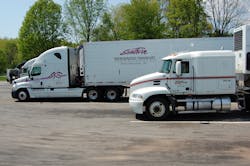So by now you’ve no doubt heard about the first “live load” of freight hauled by Otto the self-driving truck (go here and here for more on that.)
And while that’s all well and good for the future – if the industry and the general public as a whole actually get comfortable with the idea of self-driving vehicles on our roads – it doesn’t necessary offer a solution to a lot of near-term issues motor carriers now face.
The biggest one right now, though, may be freight rates – and things are not looking pretty at all on rate front for truckers right now.
John Larkin, head of the transportation & logistics equity research group at Stifel Capital Markets, offered some fairly gloomy analysis where the pricing of freight rates is concerned at the recent Surface Transportation Summit earlier this month.
Based on his analysis, Larkin said truckload (TL) pricing in the last 12 months or so, however, “has really fallen apart, particularly in the spot market, where we’ve seen reductions on the order of 10% to 15% and in some cases 20%.”
It’s reached the point, in his view, that many small carriers participating in the spot market “are really getting hammered; they’re having trouble making their truck payments and so forth.”
And if you’re having trouble making truck payments at the current freight level, I think that trouble will only be magnified by self-driving trucks, which are already predicted to be costlier than the current “human-piloted” models.
Larkin added that contract rate pressure really didn’t materialize until early this year, but the pinch on contract rates “really accelerated through” the first half of the year based on his data.“Anybody who tells you that their rates are up year over year is probably telling you a bit of a fib,” he noted. “That would be my sense of it.”
Where less-than-truckload (LTL) rates are concerned, Larkin believes they are “holding up quite nicely” as the LTL sector is more consolidated, less fragmented, and the participants are “very disciplined” in terms of rate pricing.
But not everyone agrees with that rosier LTL sentiment – even within Stifel’s own shop.
For example, Larkin’s compatriot David Ross recently noted that LTL volumes in July and August were poor, with September mixed at best as most of the LTL carriers Ross talked with indicating “continued softness” in freight pricing, while others experienced “further deterioration” in his words.
“Any way you slice it, the industrial economy in the U.S. – the main driver of LTL freight – remains weak, if not still in recession, in our opinion,” he said in a research update.
“We think overall freight is now at best flat from year-ago levels as we enter the fourth quarter,” Ross added. “Differences in carrier experience are due mainly to geography, customer base, and pricing discipline, in our view. Our optimism for volume recovery in the LTL group this cycle keeps getting pushed out, looking for one more leg higher. And the longer it takes freight to return, the more at risk pricing becomes.”Another issue compounding the “soft freight” environment is the willingness of shippers to revert to what Larkin bluntly describes as “Neanderthal practices.”
“I would tell you that there are a couple of different kinds of shippers,” he explained. “There are [those] that we call ‘enlightened’ shippers. They talk about collaboration and partnerships [with motor carriers]. But roughly half of them have reverted back to Neanderthal behavior and they don’t talk much about service anymore. They talk about price.”
For example, what that means in practice, Larkin said, is if shippers can save some money by shifting from intermodal to trucking because the spot rates are so low in the trucking market and because fuel prices are relatively low they will go ahead and do that.
“That is one of the main reasons why you’ve seen intermodal loadings down year over year, certainly,” he said.
A similar “pricing-first” mindset has affected the LTL sector, too, said Larkin. “LTL lost a lot of market share to TL as the big box retailer phenomenon played out,” he emphasized. “People discovered that you could move larger quantities at a much cheaper rate via truckload or intermodal into DCs [distribution centers] and then use, basically, a TL-based dedicated fleet or private fleet carriage to keep the stores properly loaded up with the right goods.”
Now, going forward, Larkin thinks with all the regulations coming “down the pipeline” in the U.S. at trucking there will be an inevitable “tightening” of supply and demand, especially as 2017 develops.
He believes by the middle to late part of 2017, trucking should see freight rates shift to its favor – what Larkin terms a “pricing upcycle” – if the U.S. economy continues to cook along at a 1.5% to 2% gross domestic product growth rate.
We’ll see if that comes to pass. For now, all the industry can do its wait.


